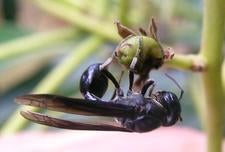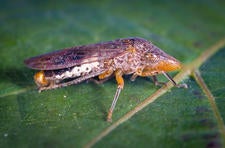Collective Research of the Hoddle Lab
Asian Citrus Psyllid
Asian citrus psyllid (ACP) is an efficient vector of the citrus disease huanglongbing (HLB), previously called citrus greening disease, which is one of the most destructive diseases of citrus worldwide. The psyllid is under eradication in Southern California.
Avocado Fruit Galling Midge
Asphondylia websteri, the alfalfa gall midge, is a polyphagous galling midge that attacks immature fruiting bodies of native and exotic crop plants in the southwestern United States. This midge emerged as a pest of cultivated legumes in the southwest in the early 1900's where larvae caused damaged to pods by feeding in the ovary and immature fruiting bodies.
Avocado Lace Bug
Avocado lace bug, Pseudacysta perseae, was first described in Florida in 1908. The common name "lace bug" is derived from the reticulate lace-like patterning of the thorax and wings of adults. There are around 154 species of lace bug found in North America. Some lace bug species in the US are important ornamental pests attacking azaleas and rhododendrons.
Avocado Leaf Galling Psyllid
Four species of leaf galling psyllid (Trioza) are currently known to attack avocado foliage and nymphal feeding causes some form of leaf deformation. All four species appear to have an extremely restricted host range and have only been recorded from leaves of avocados. Under some circumstances certain species may even be restricted to particular races of avocado.
Avocado Seed Moth
Avocado thrips were first discovered in California in 1996 as a result of damaged foliage in a Saticoy avocado orchard in Ventura County. Since this initial discovery, the thrips population has increased rapidly causing significant damage to foliage and fruit. Avocado thrips have not been recorded in any other host plant in California, suggesting a limited host plant range.
Avocado Thrips
Avocado thrips were first discovered in California in 1996 as a result of damaged foliage in a Saticoy avocado orchard in Ventura County. Since this initial discovery, the thrips population has increased rapidly causing significant damage to foliage and fruit. Avocado thrips have not been recorded in any other host plant in California, suggesting a limited host plant range.
Cover Crops as Sustainable Pest Control
Work recorded on this webpage is the first significant set of studies that have investigated the strengths and limitations of cover cropping under the unique growing conditions representative of grape producing areas of Southern California. The project investigated the use of buckwheat and cahaba vetch for management of arthropod grape pests in Temecula, California.
Cryptaspasma sp.
Very little is known about the ecology and biology of Cryptaspasma sp. Determining the pest status of Cryptaspasma sp. attacking avocados in countries exporting fruit is important for understanding the risk this insect poses to countries importing avocado fruit from areas that have endemic populations of this avocado seed-feeding moth.
Goldspotted Oak Borer
The goldspotted oak borer (GSOB) was first detected in 2004 in San Diego County, California by the California Department of Food and Agriculture during a survey for exotic woodborers. Since then, GSOB has contributed to the mortality of more than 21,500 trees over approximately 4,900 km2, and this infested area continues to increase as the GSOB population grows and spreads.
Glassy-Winged Sharpshooter
The glassy-winged sharpshooter (GWSS), likely introduced from the southeastern U.S. as eggs on nursery stock, was first observed in Orange and Ventura counties in California in 1989. It has a large plant-host range and is especially abundant on citrus.
Persea Mite
Persea mite, Oligonychus perseae, was described in 1975 from specimens collected from avocado foliage intercepted from Mexico in El Paso, TX. In California, persea mite was first discovered attacking avocados in San Diego County in 1990. Contaminated fruit bins, harvesting equipment and clothing assisted in the rapid dispersal of persea mite throughout California.
Red Banded Whitefly
Although a minor pest, honeydew production can promote the growth of black sooty mold on leaves and feeding by adult whiteflies can deform immature leaves. Attaining effective biological control of Tetraleurodes perseae is critical if this pest is to be constrained at densities which do not cause economic damage.
Large Avocado Seed Weevil
Avocado seed feeding weevils have been identified as high incursion threats to California, the largest producer of US-grown avocados, a specialty crop with a net worth of ~$350 million per year. One of these pest weevils, the big seed weevil, has been intercepted in the USA in avocado fruit exported from regions...
Past Research of the Hoddle Lab
Glassy-Winged Sharpshooter
The glassy-winged sharpshooter (GWSS), likely introduced from the southeastern U.S. as eggs on nursery stock, was first observed in Orange and Ventura counties in California in 1989. It has a large plant-host range and is especially abundant on citrus.
Vibrational Mating Calls of the Blue-Green Sharpshooter
The blue-green sharpshooter (BGSS) is a xylem-feeding leafhopper that vectors the bacterium Xylella fastidiosa, the causative agent of Pierce’s disease in grapes. This sharpshooter is native to the western United States where it is found commonly throughout much of California. Although this pest has been problematic for over 100 years, little basic research has been conducted on it.
















